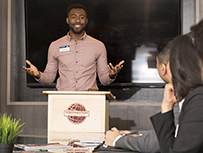 Illustration by Bart Browne
Illustration by Bart BrownePress the play button to hear techniques for opening a speech and making a good first impression.
Who is this speaker? Can he tell me anything that I don’t already know?” … “Why am I here? I have that major deadline, and I am behind schedule.” … “Where’s my cell phone? I’m going to use the time to check my email.” … “Is she going to be as boring as the last speaker?” … “I’m hungry. When’s lunch?”
Only on rare occasions is your audience anxiously awaiting your every word. Most of the time their attention is split. If you want them to take the desired action at the end of your presentation, you have to get their full attention. And you only have a few sentences to do it. That is why your opening line is one of the most important sentences in your entire presentation.
But how do you break the audience’s preoccupation in just one to three sentences? There are many techniques that can be used to open a speech. I will share a few of my favorites. All of the options, though, have a few characteristics in common: They all introduce your topic, engage the audience, and start with strength.
My favorite technique is to open with a question, but not just any question. It is one that touches a need that the audience members are feeling. The question might start with “how many times have you …?” and would then describe a problem that you are about to solve. And it tells the audience that you are addressing something that they care about.
A variant of this is “raise your hand if …” I used this technique in a Toastmasters training session on speech evaluations. My first line was “Raise your hand if you joined Toastmasters to become a better speech evaluator.” I said it in a way that suggested that I expected a “yes” answer. The audience members laughed. I then acknowledged that they joined to become better speakers, but one way to achieve that is to become a better speech evaluator. This tied the importance of the topic to their real objective. In addition, the humorous approach told them that this would not be a boring, academic presentation. And it got them participating, which continued throughout the presentation.
When you begin your speech, you are, in effect, making a first impression. Make it a good one.
I also used the question technique in a recent Toastmasters Toolbox article. It began, “When you hear the words ‘speech contest,’ what are your thoughts?” And how did I begin this article? With a question.
A second technique that I enjoy using is the intriguing statement. I especially use it when I present a tall tale, where I immediately immerse the audience into the scene. In one tale where I was performing a James Bond-themed story, I began, “I’ll never forget the day that I was mistaken for a secret agent. It was inevitable, I presume. After all, I do bear a striking resemblance to James Bond. Come back with me now to the day that changed my life forever.”
If I was giving a speech on how I became a writer, I might start with “If fifty years ago you had told me that in the year 2020 I would be writing an article for an international magazine, I would have thought you were nuts. My high school English teacher would have thought you to be the greatest comedian alive.”
Another technique that I use is the bold or shocking statement. In a segment of my training, I begin with “I am convinced that the seeds for bad speech delivery were planted back in the first grade.” Let’s say that you were speaking on improving your speaking skills. You might open with something like “90% of all speeches and presentations are boring.” That might get their attention.
Those are some examples of how you could open a speech. Notice, however, what I did not say. One opening that I hear far too often is, perhaps, the weakest way to open a speech. Imagine, the speaker walks to the platform. The audience anticipates his powerful opening, and he says “So …” That is like beginning a speech with “um.” Ugh! Speak like you have something important to say.
As the old saying goes, you only get one chance to make a good first impression. When you begin your speech, you are, in effect, making a first impression. Make it a good one. Get your audience’s attention. Show them that they are going to get value out of what you have to say. Give them a reason to put down those cellphones and pull out their notepads.
Bill Brown, DTM is a speech delivery coach in Gillette, Wyoming. He is a member of Energy Capital Toastmasters in Gillette. Learn more at billbrownspeechcoach.com.
Related Articles

Presentation Skills
5 Great Ways to Begin a Speech

Presentation Skills



 Previous
Previous
 Previous Article
Previous Article